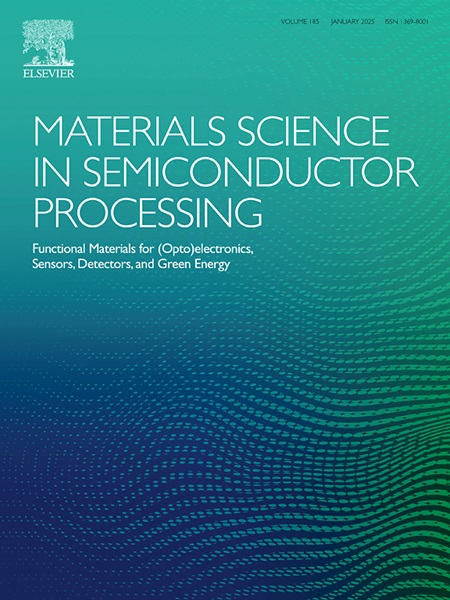Z-Scheme s掺杂CeO2/CdWO4异质结构对染料降解的增强光催化性能
IF 4.2
3区 工程技术
Q2 ENGINEERING, ELECTRICAL & ELECTRONIC
引用次数: 0
摘要
采用水热法制备了CeO2-xSx和CdWO4,通过煅烧合成了CeO2-xSx/CdWO4 (x = 0.05, 0.1, 0.2)异质结构(hs)。通过XRD、FESEM、EDX、HRTEM、UV-vis DRS、FTIR、Raman、XPS、EPR、PL、BET和电化学阻抗谱(EIS)等多种技术对其进行了广泛的表征。XRD分析表明,CeO1.9S0.1和CdWO4的晶体结构分别为立方和四方。HRTEM图像证实CeO1.9S0.1和CdWO4的形貌分别为六边形和纳米棒状。用罗丹明B (Rh B)、亚甲基蓝(MB)和抗生素环丙沙星(CIP)两种重要的纺织染料在紫外光下评价了所有化合物的光催化性能。CeO1.9S0.1、CdWO4和CeO1.9S0.1/CdWO4的比表面积(BET)分别为72.34、5.86和45.64 cm2/g。通过Mott-Schottky图估计了CeO1.9S0.1和CdWO4的能带电位。值得注意的是,CeO1.9S0.1/CdWO4 (1:1 wt%) HS表现出优异的光催化降解(PCD),在120 min内对Rh B、MB和CIP分别达到95%、93%和59%的有效降解。HSs的PCD的提高可归因于CeO2-xSx和CdWO4之间通过Z-scheme有效地分离载流子。清除剂研究进一步表明,OH•和•O2−自由基是导致Rh B和MB降解的主要因素。对CeO1.9S0.1/CdWO4 HS进行了4个循环的稳定性研究,表明CeO1.9S0.1/CdWO4 HS化合物具有更强的结构稳定性,可能成为环境修复的潜在候选者。本文章由计算机程序翻译,如有差异,请以英文原文为准。
Augmented photocatalytic performance of Z-Scheme S-doped CeO2/CdWO4 heterostructures for dye degradation
The CeO2-xSx/CdWO4 (x = 0.05, 0.1, 0.2) heterostructures (HSs) were synthesized through calcination where CeO2-xSx and CdWO4 were synthesized using the hydrothermal method. These were extensively characterized through various techniques such as XRD, FESEM, EDX, HRTEM, UV–vis DRS, FTIR, Raman, XPS, EPR, PL, BET and electrochemical impedance spectroscopy (EIS) studies. The XRD analysis asserted that the cubic and tetragonal crystal structure of CeO1.9S0.1 and CdWO4, respectively. HRTEM images confirmed the hexagonal and nanorod morphology for CeO1.9S0.1 and CdWO4, respectively. The photocatalytic performance of all the compounds was assessed using two vital textile dyes such as Rhodamine B (Rh B), Methylene Blue (MB) and antibiotic Ciprofloxacin (CIP) under UV light. The specific surface areas (BET) of CeO1.9S0.1, CdWO4 and CeO1.9S0.1/CdWO4 were measured to be 72.34, 5.86 and 45.64 cm2/g. The band potentials of CeO1.9S0.1 and CdWO4 were estimated through Mott-Schottky plots. Notably, the CeO1.9S0.1/CdWO4 (1:1 wt%) HS demonstrated superior photocatalytic degradation (PCD) and achieved an efficient degradation of 95 %, 93 % and 59 % within 120 min for Rh B, MB and CIP, respectively. The improved PCD of HSs can be attributed to the efficient separation of charge carriers facilitated via Z-scheme between CeO2-xSx and CdWO4. Scavenger studies further demonstrated that OH• and •O2− radicals were the primary agents accountable for the degradation of Rh B and MB. The stability studies conducted on CeO1.9S0.1/CdWO4 HS over four cycles indicated that CeO1.9S0.1/CdWO4 HS compound has more structural stability and could be potential candidate for environmental remediation.
求助全文
通过发布文献求助,成功后即可免费获取论文全文。
去求助
来源期刊

Materials Science in Semiconductor Processing
工程技术-材料科学:综合
CiteScore
8.00
自引率
4.90%
发文量
780
审稿时长
42 days
期刊介绍:
Materials Science in Semiconductor Processing provides a unique forum for the discussion of novel processing, applications and theoretical studies of functional materials and devices for (opto)electronics, sensors, detectors, biotechnology and green energy.
Each issue will aim to provide a snapshot of current insights, new achievements, breakthroughs and future trends in such diverse fields as microelectronics, energy conversion and storage, communications, biotechnology, (photo)catalysis, nano- and thin-film technology, hybrid and composite materials, chemical processing, vapor-phase deposition, device fabrication, and modelling, which are the backbone of advanced semiconductor processing and applications.
Coverage will include: advanced lithography for submicron devices; etching and related topics; ion implantation; damage evolution and related issues; plasma and thermal CVD; rapid thermal processing; advanced metallization and interconnect schemes; thin dielectric layers, oxidation; sol-gel processing; chemical bath and (electro)chemical deposition; compound semiconductor processing; new non-oxide materials and their applications; (macro)molecular and hybrid materials; molecular dynamics, ab-initio methods, Monte Carlo, etc.; new materials and processes for discrete and integrated circuits; magnetic materials and spintronics; heterostructures and quantum devices; engineering of the electrical and optical properties of semiconductors; crystal growth mechanisms; reliability, defect density, intrinsic impurities and defects.
 求助内容:
求助内容: 应助结果提醒方式:
应助结果提醒方式:


